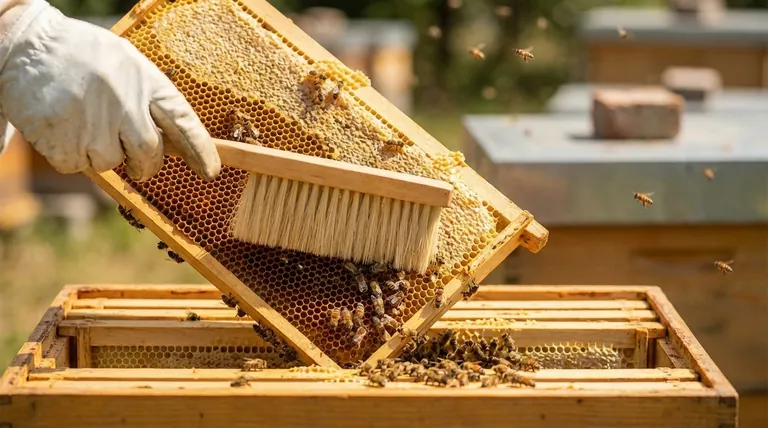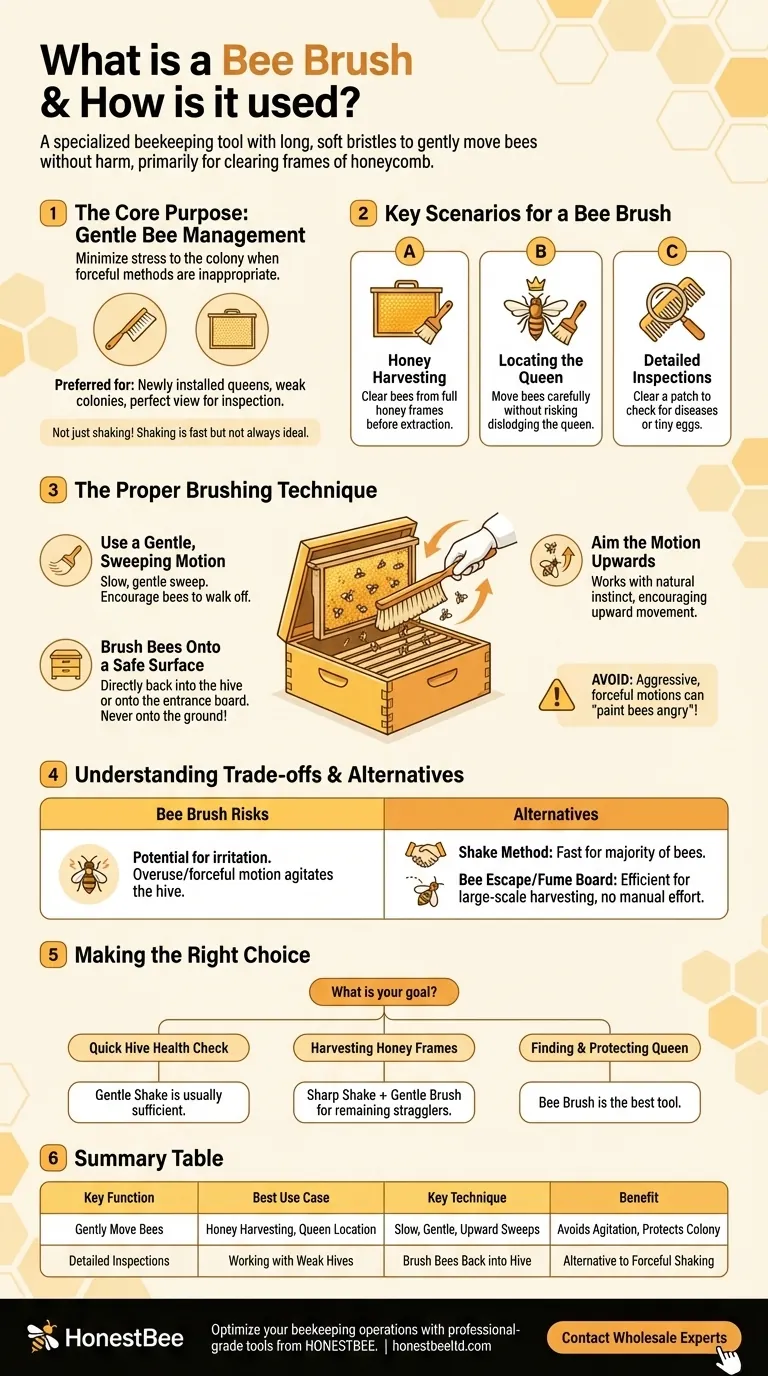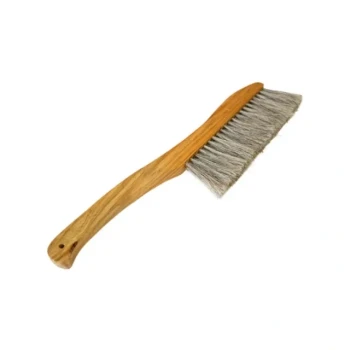In beekeeping, a bee brush is a specialized tool with long, exceptionally soft bristles designed to gently move bees off a surface without harming them. Its primary function is to clear bees from frames of honeycomb, typically right before the beekeeper removes those frames from the hive for honey extraction or a detailed inspection.
The bee brush is a fundamental tool for delicate work inside a hive, but its true value lies in the technique. While essential for certain tasks, improper or overuse can agitate the colony and cause more disruption than it prevents.

The Core Purpose: Gentle Bee Management
A beekeeper’s goal is to manage the hive with minimal stress to the colony. Every tool and technique is chosen to support this principle. The bee brush is the embodiment of gentle handling when more forceful methods are inappropriate.
Why Not Just Shake the Bees Off?
Shaking a frame with a sharp, downward motion is a very common and fast way to dislodge the majority of bees. However, this method isn't always ideal.
A bee brush is preferred when you need to be more delicate, such as when you are working with a newly installed queen, a weak colony, or when you need to clear every last bee from a frame to get a perfect view of the eggs and brood.
Key Scenarios for a Bee Brush
The brush is not used during every hive inspection. It is reserved for specific situations:
- Honey Harvesting: Its most common use is to clear remaining bees from frames full of capped honey before placing them in a bee-free box to take for extraction.
- Locating the Queen: If you need to find the queen, a brush allows you to carefully move small groups of bees aside without the risk of accidentally dislodging and losing her.
- Detailed Inspections: When checking for diseases or the presence of tiny, newly-laid eggs, a brush can clear a patch of the comb for a better view.
The Proper Brushing Technique
How you use the brush is more important than the tool itself. An aggressive technique will injure bees and provoke a defensive response from the hive.
Use a Gentle, Sweeping Motion
The correct motion is a slow, gentle sweep. You are not trying to flick the bees off the comb. Instead, you are encouraging them to walk off the frame or onto an adjacent surface.
Brush Bees Onto a Safe Surface
Never brush bees onto the grass or ground, where they can become chilled, lost, or crushed. Always brush them directly back into the open hive box or onto the entrance board so they can easily rejoin the colony.
Aim the Motion Upwards
Bees have a natural instinct to climb upwards. A gentle, upward sweeping motion often works with their instinct, encouraging them to walk up and off the top of the frame more readily than if you were to brush them downwards.
Understanding the Trade-offs and Alternatives
While useful, the bee brush is not a perfect solution for every situation. It's crucial to understand its limitations and when another method is better suited for the task.
The Risk of Agitating the Hive
The primary downside of brushing is the potential for irritation. The act of being brushed can be agitating to bees. Over-using the brush, especially with a rapid or forceful motion, is a quick way to make a calm hive defensive. This is often referred to as "painting bees angry."
Alternative: The "Shake" Method
For many beekeepers, a sharp shake is the go-to method for clearing frames. It is fast and efficient for dislodging the majority of bees. This is often sufficient for routine inspections where clearing the frame completely is not necessary.
Alternative: A Bee Escape or Fume Board
For large-scale honey harvesting, brushing individual frames is highly inefficient. Beekeepers instead use a bee escape, a one-way door placed between the honey supers and the brood box, which allows bees to leave the supers over 24-48 hours but not re-enter. This clears the boxes with almost no manual effort.
Making the Right Choice for Your Goal
Ultimately, the method you choose depends entirely on the specific task you are trying to accomplish inside the hive.
- If your primary focus is a quick hive health check: A gentle shake of the frame is usually sufficient to give you the view you need.
- If your primary focus is harvesting a few frames of honey: A combination of a sharp shake followed by gently brushing off the remaining stragglers is the most effective technique.
- If your primary focus is finding and protecting the queen: The bee brush is your best tool for carefully and safely clearing bees to locate her without risk.
Mastering the bee brush transforms it from a simple tool into an extension of your commitment to calm, respectful beekeeping.
Summary Table:
| Key Function | Best Use Case | Key Technique |
|---|---|---|
| Gently Move Bees | Honey Harvesting, Queen Location | Slow, Gentle, Upward Sweeps |
| Avoids Agitation | Detailed Inspections | Brush Bees Back into the Hive |
| Protects the Colony | Working with Weak Hives | Alternative to Forceful Shaking |
Optimize your beekeeping operations with professional-grade tools from HONESTBEE. We supply commercial apiaries and equipment distributors with the durable, reliable supplies needed for efficient and gentle hive management. Ensure the safety of your colonies and the quality of your harvest—contact our wholesale experts today to discuss your apiary's needs.
Visual Guide

Related Products
- Wooden Bee Brush with Triple Row Artificial Fiber for Beekeeping
- Classic Wooden Bee Brush with Double-Row Boar Bristles
- Wooden Bee Brush with Double-Row Horsehair Bristles
- Premium Triple-Row Horsehair Bee Brush
- Double Row Artificial Fiber Bee Brush for Beekeeping
People Also Ask
- What are some optional tools that can be useful in beekeeping? Boost Efficiency & Hive Health
- What are the key features of a popular bee brush? Essential Design for Bee Safety and Hive Hygiene
- What is the purpose of a bee brush? Master Gentle Hive Management for Healthier Bees
- Is a bee brush used to harm bees? Learn the Proper Tool for Gentle Beekeeping
- What is the purpose of a bee brush? Gently Manage Your Hive with Precision



















